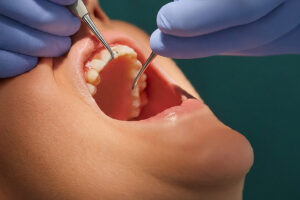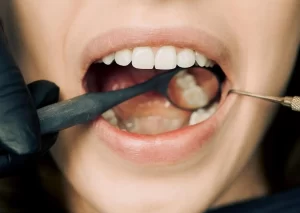Tartar on Teeth (Dental Calculus)

Ever wondered what tartar on teeth is?
A common but often misunderstood condition, also known as dental calculus, tartar is the hardened form of plaque that can cling to your teeth and gum line, leading to a variety of oral health issues if left unchecked.
Table of Contents
What Is Tartar (Dental Calculus)
Dental calculus is a hard, crusty deposit that forms on teeth and gum lines. It results from the mineralization of dental plaque, a sticky film composed of bacteria, food particles, and saliva.
When plaque is not removed through regular brushing and flossing, it can harden into tartar in as little as 24 to 72 hours.
Tartar is much more difficult to remove than plaque and requires professional dental cleaning.
Its presence can lead to gum disease and tooth decay because it provides a rough surface that encourages further plaque accumulation, exacerbating oral health problems.
What is tartar made of?
Tartar is made of hardened plaque. Plaque itself consists of a variety of substances, including:
- Bacteria: Millions of bacteria live in our mouths, forming the bulk of plaque.
- Proteins: Salivary proteins help form the matrix in which bacteria adhere.
- Food particles: Tiny bits of food that get stuck on and between our teeth.
- Minerals: Minerals from saliva, such as calcium and phosphate, contribute to the hardening of plaque into tartar.
What are the symptoms of tartar on teeth?
The symptoms of tartar on teeth can vary depending on the extent of the buildup and its impact on oral health. .
Key indicators include:
- Visible deposits: Tartar can often be seen as a yellow or brown deposit on the teeth, especially along the gumline or between teeth.
- Rough texture: Teeth may feel rough or uneven when you run your tongue over them, indicating tartar buildup.
- Gum problems: Tartar buildup can lead to gum irritation, inflammation, and bleeding, symptoms associated with gingivitis and periodontitis.
- Bad breath: Persistent bad breath (halitosis) can be a sign of tartar accumulation, as it harbors bacteria that produce foul-smelling compounds.
- Receding gums: Over time, tartar can contribute to gum recession, making your teeth look longer and your gums pull away from your teeth.
- Sensitivity: Increased sensitivity to hot, cold, or sweet foods and beverages may occur as tartar buildup can lead to enamel erosion or expose the roots of your teeth.
What causes mouth tartar?
Mouth tartar, or dental calculus, is caused by the mineralization of dental plaque. Several factors contribute to its formation:
- Plaque Accumulation: Plaque is a sticky film of bacteria, saliva, and food particles that constantly forms on the teeth. If not removed regularly through brushing and flossing, plaque can harden into tartar.
- Mineralization: Saliva contains calcium and phosphate, which can harden the plaque into tartar. This process can begin within 24 to 72 hours after plaque forms, making daily oral hygiene crucial.
- Diet: Consuming sugary and starchy foods can increase the amount of food available for bacteria in the mouth, leading to more plaque and eventually more tartar.
- Poor Oral Hygiene: Inadequate brushing and flossing fail to remove plaque effectively, allowing it to harden into tartar.
- Smoking and Tobacco Use: These habits can contribute to dryer mouth and altered saliva composition, which can accelerate tartar buildup.
- Individual Differences in Saliva Composition: Some people may have saliva that encourages faster plaque mineralization into tartar.
Risk factors for tartar
Several risk factors can increase the likelihood of tartar formation on teeth, making some individuals more prone to dental calculus than others.
Understanding these risk factors can help in preventing tartar buildup and maintaining oral health.
Key risk factors include:
- Poor oral hygiene: Inadequate brushing and flossing allow plaque to accumulate and harden into tartar.
- Irregular dental cleanings: Skipping regular dental check-ups and cleanings allows tartar to build up since only professional dental tools can remove tartar effectively.
- Diet: Frequent consumption of sugary and starchy foods can promote plaque formation, which can then harden into tartar.
- Smoking and tobacco Use: Tobacco use can increase plaque and tartar buildup and contribute to a range of oral health issues.
- Age: Older adults may be more susceptible to tartar buildup due to factors like receding gums and years of plaque accumulation.
- Dry mouth: Saliva helps neutralize acids and wash away food particles and bacteria. A lack of saliva (xerostomia) can increase the risk of tartar formation.
- Orthodontic appliances: Braces, retainers, and other orthodontic appliances can create additional surfaces for plaque to adhere to and make oral hygiene more challenging.
- Genetics: Some individuals may be genetically predisposed to more rapid plaque and tartar formation than others.
The Difference Between Plaque and Tartar
Plaque and tartar are related but distinct components of dental health concerns, each contributing to oral hygiene issues in different ways.
Plaque:
- Plaque is a soft, sticky film that forms on the teeth and gum line. It’s composed of millions of bacteria, along with saliva, food particles, and other natural substances.
- It forms constantly on the teeth and can be removed by regular brushing and flossing.
- Plaque is colorless or pale yellow and can lead to tooth decay and gum disease if not removed promptly.
- It begins to form on the teeth 4 to 12 hours after brushing, which is why daily dental care is crucial.
Tartar:
- Tartar, also known as dental calculus, is the hardened form of plaque that has mineralized on the teeth.
- It develops when plaque is not removed and is allowed to accumulate and harden. This process can take as little as 24 to 72 hours.
- Tartar is tougher and more adherent than plaque, making it difficult to remove with standard brushing and flossing. It typically requires professional dental cleaning.
- It can vary in color from yellow to brown and forms above and below the gum line, contributing to more severe dental issues like periodontitis.
In summary, while plaque is a soft, easily removable film that forms continuously, tartar is the hardened, more permanent result of neglected plaque.
What are the complications of having tartar on your teeth
Having tartar on your teeth can lead to several oral health complications, including gum disease (gingivitis and periodontitis), which can result in gum recession, bleeding, and infection.
Tartar buildup also increases the risk of tooth decay and cavities by providing a surface for bacteria to adhere to and produce harmful acids.
It can also contribute to bad breath and potentially lead to tooth loss if gum disease progresses untreated.
Tartar’s rough surface can further irritate the gums and exacerbate existing dental issues.
How do dentists diagnose tartar?
Dentists diagnose tartar through a combination of visual examination and dental instruments. During a check-up, the dentist or dental hygienist uses a small mirror to inspect all surfaces of the teeth and gums for signs of tartar, which appears as a hard, yellow or brownish deposit.
They may also use a dental explorer, a sharp tool, to gently probe the teeth and gum line, identifying areas where tartar has formed by feeling for rough surfaces that indicate calculus buildup.
In some cases, dental X-rays may be used to detect tartar below the gum line, where it’s not visible to the naked eye. This thorough examination helps determine the extent of tartar accumulation and guides the cleaning process.
How do you treat tartar?
Treating tartar involves professional dental procedures and good oral hygiene practices. Here’s how tartar is treated:
- Professional cleaning: The primary method for tartar removal is a professional cleaning by a dentist or dental hygienist. They use special tools, such as scalers and ultrasonic devices, to carefully remove tartar from above and below the gum line. This process is known as scaling.
- Root planing: For tartar that has spread below the gum line, root planing may be necessary. This procedure smooths the root surfaces, discouraging further tartar buildup and helping the gums to reattach to the teeth.
- Polishing: After scaling, teeth are often polished to smooth the surfaces, making it harder for plaque and tartar to adhere.
- Fluoride treatment: Sometimes, a fluoride treatment is applied after cleaning to strengthen the enamel and help prevent cavities.
Preventing tartar from forming is key to avoiding extensive treatments. This involves:
- Brushing teeth twice daily with fluoride toothpaste.
- Flossing daily to remove plaque between teeth.
- Using an antiseptic mouthwash to help kill bacteria in the mouth.
- Eating a balanced diet and limiting sugary snacks.
- Quitting smoking and tobacco use.
- Visiting the dentist regularly for check-ups and cleanings, typically every 6 months.
How can I prevent tartar buildup?
Preventing tartar buildup involves maintaining a thorough oral hygiene routine and making lifestyle adjustments. Here are effective strategies to prevent tartar formation:
- Brush twice daily: Use fluoride toothpaste and a soft-bristled toothbrush to brush your teeth for two minutes, focusing on all surfaces of the teeth, especially near the gum line and hard-to-reach back teeth.
- Floss daily: Flossing once a day helps remove plaque and food particles from between the teeth and under the gum line, areas your toothbrush can’t reach.
- Use antiseptic mouthwash: Incorporating an antiseptic mouthwash into your daily routine can help reduce plaque and prevent tartar buildup.
- Eat a balanced diet: Limit sugary and starchy foods and snacks, which can contribute to plaque formation. Instead, opt for a diet rich in fruits, vegetables, and whole grains.
- Stay hydrated: Drinking plenty of water promotes saliva production, which helps wash away food particles and bacteria.
- Quit smoking: Tobacco use increases the risk of tartar buildup, as well as gum disease and other oral health issues.
- Regular dental visits: Visit your dentist or dental hygienist for professional cleanings and check-ups at least twice a year. These visits are crucial for removing any tartar that has formed and for catching early signs of gum disease.
- Consider dental sealants: For individuals prone to tartar buildup, dental sealants can provide an additional protective barrier against plaque on the chewing surfaces of the back teeth.
FAQ on Tartar on Teeth (Dental Calculus)
Does tartar smell bad?
Yes, tartar can contribute to bad breath due to the bacteria it harbors. Tartar provides a rough surface that allows plaque and the bacteria within it to adhere more easily and accumulate. These bacteria can produce foul-smelling compounds as they metabolize food particles and release waste products. On top of that, as tartar builds up, it can lead to gum disease, which is another source of bad breath.
How do you remove tartar from teeth?
Tartar removal from teeth requires professional dental cleaning. Dentists or dental hygienists use special tools, such as scalers and ultrasonic devices, to gently scrape away tartar from above and below the gum line. This process, known as scaling, is the only effective way to remove tartar buildup.
What happens if I don’t remove tartar?
If tartar is not removed, it can lead to gum disease, tooth decay, and bad breath. Over time, tartar buildup irritates and inflames the gums, causing gingivitis, which can progress to periodontitis, a more severe gum disease that can result in tooth loss. Tartar also provides a rough surface that harbors bacteria, increasing the risk of cavities.
Does tartar on teeth go away?
Tartar on teeth does not go away on its own. Once plaque hardens into tartar, it can only be removed by a dental professional using special tools. Read more: Tartar Breaking Off Teeth
How do you remove tartar from a dental pick?
To remove tartar from a dental pick, follow these steps:
– Rinse and soak: Immediately after use, rinse the dental pick under warm water to remove any loose debris. Soak it in a disinfecting solution or mouthwash for a few minutes.
– Clean with soap: Use a small brush (an old toothbrush works well) and antibacterial soap to gently scrub the dental pick, focusing on the tip and any grooved areas where tartar may accumulate.
– Rinse thoroughly: Rinse the dental pick under warm water again to remove any soap residue.
– Disinfect: Soak the dental pick in rubbing alcohol for a few minutes to disinfect it, then rinse it again under warm water.
– Dry: Allow the dental pick to air dry completely before storing it to prevent bacterial growth.
Regularly inspect the dental pick for any signs of wear or damage. Replace it if necessary to ensure it’s safe and effective for use.
Fact Checked
Our dedicated team rigorously evaluates every article and guide to ensure the information is factual, up-to-date, and free of bias.
Updated Regularly
We update our articles and reviews regularly to ensure you have access to the latest data in the dental industry.
The content on Dental3DU’s blog is intended for educational purposes only. This information should not be relied upon as professional medical counsel. Be sure to always consult with your dentist about the dangers and benefits of any medication, treatment or procedure.







